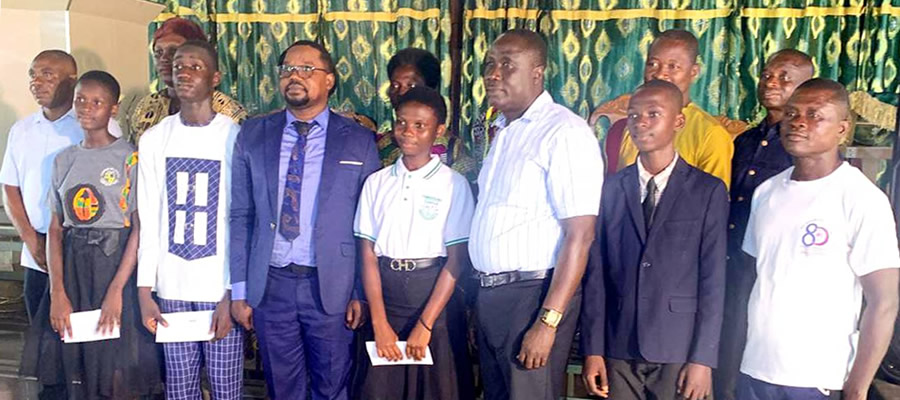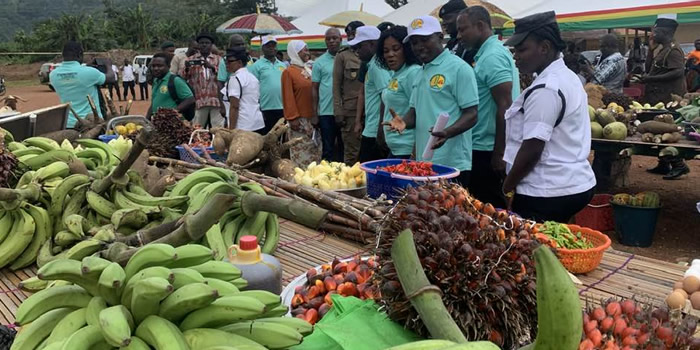

Physical and Natural Environment
It is an undeniable fact that, the society man lives in is not devoid of problems. However, as these problems are identified efforts have to be made to propose solutions as a way of addressing these problems in a sustainable manner to improve upon the quality of life of the people.
Development Planning as a discipline takes conscious efforts to identify societal problems, analyze them critically with the aim of bringing improvement in the lives of the people. This section of the report looks at the location and size of the district, relief and drainage pattern, climate and vegetation, soil and crop potentials, aesthetic features and finally geology and mineral.
Location and Size
Obuasi East District Assembly is part of the forty-three (43) and Two Hundred and Fifty-Four ((261) Metropolitan/Municipal/ District Assemblies in Ashanti Region and Ghana respectively. The district is located between latitudes 6º 75N and 6º 90N, and longitudes 1º 20’W and 1º 60’W. It covers a total land area of 283.686 square km constituting 1.16% of the total land area of Ashanti region (24,389sq.km.). It is located in the Southern part of the Ashanti Region of Ghana, with about 66km from Kumasi, the regional capital.
There are two major roads linking the district capital from Kumasi; namely the Kumasi-Bekwai-Adansi Asokwa road and the main Kuamsi Obuasi road. The district is bounded to the north by Adansi North District, south by Adansi Akrofrom District, east by Adansi Asokwa District and west by Obuasi Municipal. Other major settlements in the district include Tutuka, Bossman, Wawase, Kwabrafoso, Boete, Brahabebome, Asonkore, Akaporiso, Pomposo, Kwabenakwa etc.
There are about thirty-four (34) communities/settlements in the district which have been delineated into three (3) Town Councils and subdivided into 19 Electoral Areas for the purpose of District Assembly elections and controlled under one (1) Parliamentary Constituency. From the 2010 Population and Housing Census by Ghana Statistical Service, the district has a population of 56,882 with a growth rate of 2.7%. The current population is estimated to be 70,394 in 2018. However, the population for the district in 2019 is projected to 72,295
Fig. 2 Map Showing Obuasi East District in National Context
Source: Physical Planning Department-OMA, 2018
Fig. 4 Obuasi East District Map
Source: Physical Planning Department-OMA, 2018
Climate
The district experiences semi-equatorial climatic conditions with a double maximum rainfall regime. Mean annual rainfall ranges between 125 cm and 175 cm. Temperatures are uniformly high all year with the hottest month being March when 30oC is usually recorded. Mean average annual temperature is 25.5oC. Relative humidity is highest (75% - 80%) in the wet season.
Vegetation
The vegetation is predominantly a degraded semi-deciduous forest. The forest consists of limited species of hard wood, which are harvested as timber. The AngloGold Ashanti has maintained large tracts of teak plantation as green belts covering 12.10km2 within its concession. Also 290 hectares of land has been acquired by the Assembly from AGA to plant economic trees.
Implication of Vegetation to Development
In spite of the level of degradation of the forest, it still holds some economic potential to aid the District’s development in terms of revenue from the hard wood.
Several Decades Back: Thick Forest 1995 – 2005: Secondary Forest
Relief and Drainage
Generally, the district has an undulating terrain with more of the hills rising above 500 meters above sea level. The highest point is located on the Pomposo range at 634 metres near Obuasi. Highland ranges include Dampaia (the most extensive) in the east, Kusa in the north east, and Pompo. No area falls below 100 metres above sea level.
The district has an undulating terrain with most of the hills rising above 500 meters above sea level. The highest point is located on the Pompo range at 634 meters near Obuasi. Highland ranges is located at Pomposo.
The district is drained by streams and rivers which include; Pompo, Akaporiso, Other perennial streams and rivers like Kwabrafo all of which depict dendritic pattern of flow. All these rivers are polluted by mining and other human activities. Again the municipality is endowed with springs which can be tapped as potable drinking water
Pictorial view of some Relief and Drainage features in the District Mountain
Soils and Agricultural Land Use
The soil type in the district include
Clay Loam soil
Loamy soil
Sandy loam soil
Biodiversity, climate change, green economy and environment
Climate Change
Climate change has become a serious challenge around the globe of which Obuasi East District is no exception. A number of environmental challenges which has brought about changes in temperature or the atmospheric conditions are inevitable. Key factors amongst them include lumbering, soil erosion, mining, bad farming practices (slush and burn), waste disposal and bushfires.
The incidence of climate change in the country manifesting in sudden changes in weather pattern, erratic rainfall among others with their adverse effect give cause for concern and measures should be put in place to mitigate the harmful effects. The haphazard construction of houses especially on water ways and wetlands/flood prone areas, deforestation, improper layouts, excessive emission of carbon dioxide into the atmosphere illegal mining activities that has polluted many rivers like the Kwabrafo, Pompo and Jimi are among the numerous factors that have worsened the situation Due to all these the district Assembly has outlined the following measures to address the situation;
· To consider environmental impact on all human and development activities before embarking on them.
· To continually educate the public on climate change and its impact on development
· To adopt measures to control bushfires
· Enforce building control regulations
· To encourage irrigation farming
· To enforce environmental sanitation standards
· Tree planting and land scrapping to be encourage on all our construction sites where appropriate.
· To teach climate change as a subject in our schools
· To enforce the conservation of our wetlands.
· To check deforestation and illegal mining.
· To plant trees along river banks
The effects of these activities have brought about serious environmental challenges such as land degradation, air pollution, pollution of water bodies and reduction in water volumes during the dry season. Some streams dry off completely because they are directly exposed to the sun. Also forest reserves are being depleted due to human activities such as lumbering and mining, leading to the depletion of economic tree species. This climate change has accounted for the erratic pattern of rainfall which has affected agricultural activities in the district for the past years.
The change of original vegetation due to climate change has given rise to: (a) exposure of communities to rain and wind storm disasters with their attendant problems, (b) seasonal flow of the rivers in the affected areas thereby depriving the communities that depend on the streams for domestic and other activities of their means of livelihood. The change in the vegetation due to climate change has affected the farming practices and the crops that are cultivated by the farmers.
Afforestation project when successfully carried out will improve all year round flow of the rivers and improve the living conditions of communities which depend on the rivers for supply of water for domestic and economic activities.
Environmental Concern The Assembly has to impose by-laws to drastically reduce all activities that have the potential to either destroy or degrade the environment. Such activities in the district include Sand and Stone winning and haphazard development of settlements.
Also, environmental sanitation would receive serious consideration and attention by upholding and enforcing sanitation by-laws put in place to curb the menace of environmental degradation.
Water Security
There is double maximum rainfall pattern as experienced in the district presents opportunity for rain harvesting. Access to safe water constitutes essential ingredients for safeguarding the health and lives of the people. Sources of water in the district are pipe borne water, boreholes, hand-dug wells fitted with pump, open hand dug wells, rivers/streams and rain water. Boreholes and pipe are the commonest sources of drinking water for the people in the District.
A cursory look at the map of the district reveals that the district abounds in water sources with streams, rivers and ponds in most parts of the district. However, these water sources are heavily polluted by the mining activities of AngloGold Ashanti and illegal miners popularly called galamsey.
This situation is further compounded by human activities like sand winning, indiscriminate defecation into rivers and streams. The non-availability of dumping sites in some communities has resulted in the use of some of these water bodies as dumping sites. A number of interventions have been implemented in the district and this has improved upon access to potable water supply.
Currently, the District in collaboration with the Community Water and Sanitation Agency is putting in measures with financial support from the Government of Ghana, to increase access to potable water to a greater proportion of the population in the district.
Access to Portable Water
Water is a very essential resource in every community’s development. It is therefore very important for every member of the community to have access to portable water for consumption. The need to assess the existing situation of water and sanitation in the process of the plan preparation is very crucial. The findings will serve as inputs which will advise both policy and strategy formulation.
Currently, there are 11 boreholes district wide. In all, access to potable water coverage is …...% as against target of 100%. The main sources of water supply in the district include pipe borne, boreholes and wells.
The following present potentials that could be tapped to improve the water situation in the District:
· Relatively high water table
· The presence of Community Water & Sanitation Plan
· Strong District Water and Sanitation Team
· Presence of Community Water and Sanitation Agency
· Internal Generated Funds and District Assembly Common Fund
· Well trained WATSAN Committee
· Trained Area Mechanics
Natural and Man-made Disaster
A disaster is an event which affects human beings, that is, life, properties, infrastructure and environment. It destructs day to day life and renders affected communities unable to cope with daily life. It creates needs for external assistance and has a causative agent which includes wind, rain, blasts bomb and accidents. It happens suddenly and gives no warning. A hazard is also defined as a rare or extreme natural or human-made event that threatens or adversely affects human life, property or activity to the extent of causing a disaster. Various forms of disaster exist in the district. Examples of such disasters include fire outbreak, rainstorm, floods etc.
The district is a disaster prone area due to the mining activities. This is mainly caused by illegal mining activities. Most casualties are suffered by the illegal miners who are sometimes trapped in holes they have dug during their mining activities. There are cases of disaster caused by rain storms and flooding in the district.
Impact of Human Activities including Farming and Bush Fires
The major activity that has impacted negatively mostly on land in the district is mining. This has resulted in the loss of primary forest, creation of manholes and the littering of the environment with scrap metals. Agriculture on the other hand has suffered a down turn due to loss of cultivable land to Mining.
Some communities in the district have experienced disasters of many forms; natural and man-made disasters. The table below represent disaster occurrence in the Obuasi East district, the form of disaster and the community in which the disaster occurred.
Table 1.12: List of Disaster Occurrence and their Forms of Disaster in the Obuasi East District from 2014-2018.
Source: NADMO Office-Obuasi, 2018
The National Disaster Management Organization (NADMO) in collaboration with the Ghana National Fire Service and the Ghana Police Service have been charged with the responsibility of managing disaster issues in the district. It is in their jurisdiction to provide relief for victims of such disasters as fire outbreaks, Rainstorm and floods as and when they occur. It is also with them to educate on the best life saving practices during such disasters. One challenge that faces the department however is where to get both financial and material resources for their operation. Their major functions in the Districts are to;
· Provide assistance to victims of disaster
· educate the public on disaster prevention measures
Source: NADMO Office-Obuasi, 2018
The table below shows the total number of Disaster Victims in Fire, Rain/Wind Storm, Flooding and Drowning in 2014, 2015, 2016, 2017 and 2018 respectively.
Table 1.14 Forms of Disaster in Obuasi East District
Source: NADMO Office-Obuasi, 2018
Natural Resource Utilization
Geology and Minerals
The District is endowed with a number of resources, which are potentials for development. Some of these resource potentials are tapped whilst others are not. The resources include gold, rock, sand, stone, clay deposits and forest resources. The vegetation is predominantly a degraded semi-deciduous forest. The forest consists of limited species of hard wood, which are harvested as timber. The AngloGold Ashanti has maintained large tracts of teak plantation as green belts covering 12.10km2 within its concession.
Rocks in the district are mostly of Tarkwain (Pre-cambrian) and Upper Birimian formation which are noted for their rich mineral bearing potentials. Areas around the contacts of the Birimian and Tarkwain zones known as reefs are noted for gold deposits. The Obuasi mine (AngloGold Ashanti) which works on steeply dipping quartz veins over a strike length of 8km has since 1898 produced over 600 tons (18 million ounces) of gold from ore averaging about 0.65 ounces per ton.
These mineral deposits provide a great potential for socio-economic development of the district. Jobs are created for the local people and revenues derived from these resources are used to provide socioeconomic infrastructure to quicken the pace of the district’s development.
Natural resources that can be identified in the municipality include rivers, rocks, forest, sand clay and gold. The rocky hills and out crops in the municipality ranging between 250 and 300 metres above sea level have immense potential for stone quarrying in the local economy. Also the water bodies available can be harnessed for irrigation schemes to aid agricultural production.
The natural environment of the municipality is degraded to some extent. This takes the form of air, water pollution and land degradation due to mining activities and deforestation. Efforts have been made on the part of the mining companies in reclaiming lands where surface mining took place. Such areas have been planted with economic trees which include Teak and Mahogany. So far about 5600 hectares of degraded land has been reclaimed.
Date Created : 5/24/2023 12:00:00 AM












 facebook
facebook
 twitter
twitter
 Youtube
Youtube
 +233 593 831 280
+233 593 831 280 0800 430 430
0800 430 430 GPS: GE-231-4383
GPS: GE-231-4383 info@ghanadistricts.com
info@ghanadistricts.com Box GP1044, Accra, Ghana
Box GP1044, Accra, Ghana